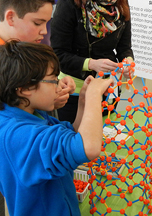STEM-driven NanoDays slated for April 10-11 at Discovery Park's Birck Nanotechnology Center
March 31, 2014
 |
|
Hundreds of students, teachers and parents learned what the world of nanotechnology is all about during NanoDays 2014 in Purdue University's Discovery Park. The annual event is a big draw for students and teachers in grades 4-12, bringing together through hands-on learning activities and programs the principles of science, technology, engineering and mathematics (STEM). (Purdue University photo/Tanya Faltens) Download Photo |
WEST LAFAYETTE, Ind. - The amazing world of small will be incredibly big throughout Purdue University's Discovery Park on April 10-11 for the 2014 edition of NanoDays centered at the Birck Nanotechnology Center.
Hundreds of young students, teachers and parents are registered to participate in the fourth annual NanoDays, with special activities for students in grades 4-12.
"Our faculty, students and staff at the Birck Nanotechnology Center are thrilled once again to host hundreds of young and enthusiastic students who want to learn more about this innovative and exciting field," said Ali Shakouri, the Mary Jo and Robert L. Kirk Director of the Birck Nanotechnology Center and a Purdue professor of electrical and computer engineering.
"Nanomaterials have become a key part of the many technological advances in our world today - from exciting breakthroughs in medicine, computing, sensing, energies and materials technology to cloaking and easy-to-clean trousers."
While registration is closed for NanoDays, a special NanoDays exhibit and tent on April 12 will be a part of Purdue's Spring Fest activities for those interested in learning more about nanotechnology.
A team led by Tanya Faltens and Jaime Turner is organizing this year's NanoDays, and nearly 100 undergraduate and graduate students from the Birck Nanotechnology Center and a variety of disciplines across campus are assisting.
"We hope to spark an interest in these students about careers in science and engineering - and that they come to view themselves as future Purdue students and scientists," said Faltens, Educational Content Creation manager for nanoHUB.org at Purdue.
Once again, Purdue is partnering with the Girl Scouts of Central Indiana for this program and its focus on the principles of science, technology, engineering and mathematics (STEM). Girl Scouts from throughout the state will participate in a reception from 6-8 p.m. April 9 at Birck.
"Through these and other Girl Scout STEM activities, we hope this Purdue-led festival of educational programs about nanoscale science and engineering and its potential impact on the future will give these girls the confidence in themselves to continue to explore the sciences into the future," said Jaime Hubbard, program manager for the Girl Scouts of Central Indiana.
Several thousand K-12 educators, students and others have participated in NanoDays each year since the event came to Purdue in 2010. Co-sponsored by the Nanoscale Informal Science Education Network, NanoDays is a nationwide festival of educational programs about nanoscale science and engineering and its potential impact on the future.
Nanotechnology is the ability to measure, manipulate and manufacture objects between 1 and 100 nanometers in size. A nanometer is one billionth of a meter; a human hair is roughly 100,000 nanometers in diameter.
Here are some of the activities, games and demonstrations at Purdue NanoDays 2014:
* Exploring Fabrication-Gummy Capsules, which lets visitors make self-assembled polymer spheres. They learn that self-assembly is a process by which molecules and cells form themselves into functional structures. It's also used to make nanocapsules that can deliver medication.
* Exploring Forces-Static Electricity, which is a hands-on activity where visitors discover that electrostatic forces cause smaller balls to be suspended in a tube while larger ones fall to the bottom. They also learn that size can affect the way a material behaves.
* Exploring Tools-SPM, a hands-on activity in which visitors use a flexible magnet as a model for a scanning probe microscope, a tool that scientists use to work at the nanoscale level.
* Exploring Products-Nano Sand, which is a hands-on activity exploring how water behaves differently when it comes in contact with nano sand and regular sand. Visitors learn about the hydrophobic properties of nano sand.
The Birck Nanotechnology Center, an 187,000-square-foot facility, is a cornerstone of Discovery Park's interdiciplinary efforts. It involves more than 300 faculty, staff and graduate students from 36 schools and departments at Purdue, advancing research in nanoscale science and engineering with applications in areas such as health care, energy, communication, computer technology and food safety.
Writer: Phillip Fiorini, 765-496-3133, pfiorini@purdue.edu
Sources: Ali Shakouri, 765-496-6105, shakouri@purdue.edu
Tanya Faltens, 765 494-6318, tfaltens@purdue.edu
Jaime Hubbard, 317-924-6859, jhubbard@girlscoutsindiana.org

